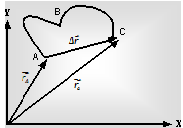The part of mechanics which works with the description of the motion of an object without considering reason of the origin is known kinematics. Whereas, the study of the motion of an object related to its cause is called dynamics.
(i) Motion in one dimension: Motion of an object in a straight line is known one dimensional motion. The location of a particle in one dimensional motion can be defined by only one variable (say x). For a particle rolling along a straight line (1-D motion) all the vector quantities such as velocity, position, acceleration and displacement have only one non-zero element.
(ii) Motion in two dimensions: Motion of an object in a plane is known two dimensional (2-D) motions. For 2-D motion acceleration or velocity can be defined by two elements in any two mutually perpendicular directions in Cartesian coordinate machine i.e. its velocity, position, acceleration and displacement can have two nonzero elements.
(iii) Distance & Displacement: Displacement: - The modification in position of a body in a particular direction is called as displacement. It is a vector function and its unit in SI system is meter.
Distance: The actual length of path traversed by a body in a sub interval of time is known as distance. It is the actual path travelled by an object between its final and initial positions. It is a scalar function and its unit in SI is meter. Displacement can be positive, zero or negative but distance is always positive. If a particle goes in a straight line without modification in its direction, the value of displacement is same to the distance travelled. Otherwise it is usually less than it. Thus, Displacement distance
(iv) Average Velocity and Speed: The average speed of a substance in a given interval of time is described as the ratio of the distance completed to the time taken while; average velocity is described as the ratio of the displacement to the time taken.
|
If a particle travels from A to C through a path ABC. Then distance (ΔS) covered is the actual covered length ABC, while the displacement is,


Thus, if the distance covered is and displacement of a particle is in a required time interval then
|
|

(v) Instantaneous Speed and Velocity: Instantaneous velocity and speed are described at a particular instant and are shown by,

(vi) Average and Instantaneous Acceleration: Average acceleration is described as the change in velocity  over a given time interval Δt .
over a given time interval Δt .
Hence, 
The instantaneous acceleration of given particle is the rate at which its velocity is modify at that instant i.e.,

Email based Physics assignment help - homework help at Expertsmind
Are you searching physics expert for help with Motion in One Dimension questions? Motion in One Dimension topic is not easier to learn without external help? We at www.expertsmind.com offer finest service of Physics assignment help and physics homework help. Live tutors are available for 24x7 hours helping students in their Motion in One Dimension related problems. We provide step by step Motion in One Dimension question's answers with 100% plagiarism free content. We prepare quality content and notes for Motion in One Dimension topic under physics theory and study material. These are avail for subscribed users and they can get advantages anytime.
Why Expertsmind for assignment help
- Higher degree holder and experienced experts network
- Punctuality and responsibility of work
- Quality solution with 100% plagiarism free answers
- Time on Delivery
- Privacy of information and details
- Excellence in solving physics queries in excels and word format.
- Best tutoring assistance 24x7 hours